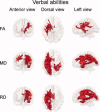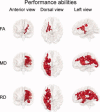Intellectual abilities and white matter microstructure in development: a diffusion tensor imaging study
- PMID: 20162594
- PMCID: PMC6871099
- DOI: 10.1002/hbm.20962
Intellectual abilities and white matter microstructure in development: a diffusion tensor imaging study
Abstract
Higher-order cognitive functions are supported by distributed networks of multiple interconnected cortical and subcortical regions. Efficient cognitive processing depends on fast communication between these regions, so the integrity of the connections between them is of great importance. It is known that white matter (WM) development is a slow process, continuing into adulthood. While the significance of cortical maturation for intellectual development is described, less is known about the relationships between cognitive functions and maturation of WM connectivity. In this cross-sectional study, we investigated the associations between intellectual abilities and development of diffusion tensor imaging (DTI) derived measures of WM microstructure in 168 right-handed participants aged 8-30 years. Independently of age and sex, both verbal and performance abilities were positively related to fractional anisotropy (FA) and negatively related to mean diffusivity (MD) and radial diffusivity (RD), predominantly in the left hemisphere. Further, verbal, but not performance abilities, were associated with developmental differences in DTI indices in widespread regions in both hemispheres. Regional analyses showed relations with both FA and RD bilaterally in the anterior thalamic radiation and the cortico-spinal tract and in the right superior longitudinal fasciculus. In these regions, our results suggest that participants with high verbal abilities may show accelerated WM development in late childhood and a subsequent earlier developmental plateau, in contrast to a steadier and prolonged development in participants with average verbal abilities. Longitudinal data are needed to validate these interpretations. The results provide insight into the neurobiological underpinnings of intellectual development.
© 2010 Wiley-Liss, Inc.
Figures







References
-
- Ashtari M, Cervellione KL, Hasan KM, Wu J, McIlree C, Kester H, Ardekani BA, Roofeh D, Szeszko PR, Kumra S ( 2007): White matter development during late adolescence in healthy males: A cross‐sectional diffusion tensor imaging study. Neuroimage 35: 501–510. - PubMed
-
- Barnea‐Goraly N, Eliez S, Hedeus M, Menon V, White CD, Moseley M, Reiss AL ( 2003): White matter tract alterations in fragile X syndrome: Preliminary evidence from diffusion tensor imaging. Am J Med Genet B Neuropsychiatr Genet 118B: 81–88. - PubMed
-
- Beaulieu C ( 2002): The basis of anisotropic water diffusion in the nervous system—A technical review. NMR Biomed 15: 435–455. - PubMed
-
- Casey BJ, Tottenham N, Liston C, Durston S ( 2005): Imaging the developing brain: What have we learned about cognitive development? Trends Cogn Sci 9: 104–110. - PubMed
Publication types
MeSH terms
LinkOut - more resources
Full Text Sources
Miscellaneous

